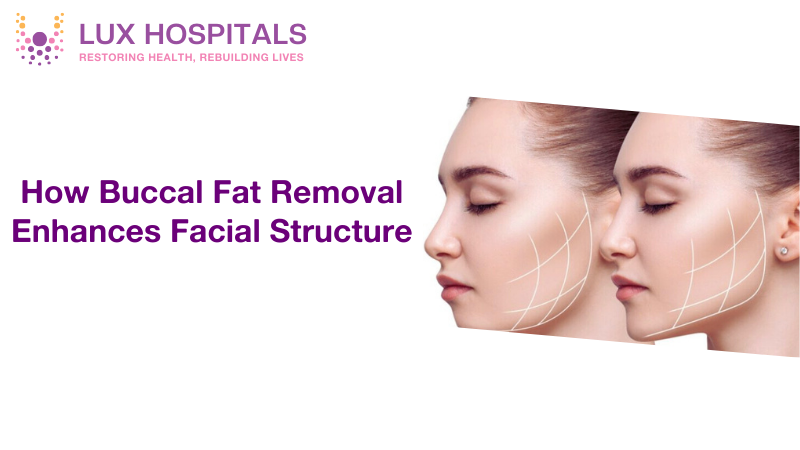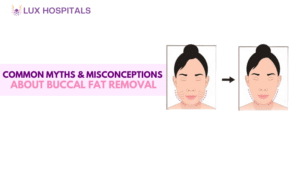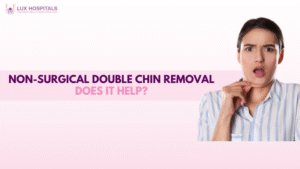How Buccal Fat Removal Enhances Facial Structure

Buccal fat removal has become a popular cosmetic procedure for those seeking a more defined and sculpted facial appearance. This minimally invasive surgery involves removing excess fat pads from the cheeks to create a slimmer, more contoured look. Celebrities and influencers have helped popularize this procedure, making it one of the most sought-after facial contouring techniques.
In this blog, we’ll explore how buccal fat removal enhances facial structure, the procedure’s benefits, and what to expect before and after the surgery.
What Is Buccal Fat Removal?
Buccal fat removal surgery is a cosmetic surgery that targets the buccal fat pads — the fat deposits located in the lower cheeks. These pads contribute to the roundness and fullness of the face. While some people naturally have more prominent buccal fat pads, others may develop them due to weight gain or genetic factors.
The goal of buccal fat removal surgery is to reduce the size of these fat pads, creating a more contoured and chiseled appearance. The procedure enhances the natural hollows of the cheeks, giving the face a leaner and more defined look.
How Buccal Fat Removal Enhances Facial Structure
The structure of facial bones plays a significant role in the overall appearance of the face. High cheekbones, a defined jawline, and a balanced facial proportion contribute to an attractive look. However, excess buccal fat can obscure these natural features, making the face appear round or puffy.
1. Accentuates the Cheekbones
Removing excess buccal fat exposes the underlying cheekbones, giving them more definition. A well-defined cheekbone structure enhances the overall balance and symmetry of the face.
2. Defines the Jawline
Buccal fat removal creates a more sculpted lower face by reducing the fullness in the cheeks. This leads to a sharper and more prominent jawline, which is often considered a sign of youth and beauty.
3. Balances Facial Proportions
Excess fat in the cheeks can make the face appear disproportionate or top-heavy. Buccal fat removal helps to balance the upper and lower parts of the face, creating a more harmonious look.
The Buccal Fat Removal Procedure
Buccal fat removal is a straightforward surgical procedure performed under local anesthesia. Here’s a step-by-step overview:
1. Consultation
Before the surgery, a consultation with a plastic surgeon is essential. The surgeon will evaluate your facial structure, discuss your goals, and determine if you’re a suitable candidate for the procedure.
2. Anesthesia
Local anesthesia is typically used to numb the area and ensure the patient’s comfort during the procedure.
3. Incision
A small incision is made inside the mouth, near the inner cheeks. This approach ensures that there are no visible scars on the face.
4. Fat Removal
The surgeon carefully removes the buccal fat pads, ensuring that the right amount of fat is extracted to achieve a natural and balanced look.
5. Suturing
The incision is closed with dissolvable stitches. Since the incision is inside the mouth, no external scarring occurs.
Buccal Fat Removal Before and After
Patients often notice a significant improvement in their facial contour after the procedure. Here’s what to expect:
Before the Procedure:
- Facial fullness or “baby face” appearance
- Lack of cheekbone and jawline definition
- Round or puffy cheeks
After the Procedure:
- More defined cheekbones and jawline
- Slimmer and more sculpted face
- Improved facial symmetry and balance
The final results typically become visible within a few weeks as the swelling subsides. Most patients report increased confidence and satisfaction with their enhanced facial structure.
Buccal Fat Removal Surgery: Recovery and Aftercare
Recovery from buccal fat removal surgery is relatively quick and uncomplicated. Here’s what to expect during the healing process:
1. Swelling and Bruising
Mild swelling and bruising are common after the procedure. Applying ice packs and keeping the head elevated can help reduce swelling.
2. Soft Diet
Since the incision is inside the mouth, patients are advised to follow a soft diet for the first few days to avoid discomfort and irritation.
3. Oral Hygiene
Maintaining good oral hygiene is crucial to prevent infection. Your surgeon may recommend a special mouth rinse to keep the area clean.
4. Avoid Strenuous Activity
Patients should avoid intense physical activity for about a week to allow proper healing.
Most patients can return to their normal routine within a week, with full results becoming visible in about three to four weeks.
Who Is a Good Candidate for Buccal Fat Removal Surgery?
Not everyone is an ideal candidate for buccal fat removal Surgery. The procedure is most suitable for:
- Individuals with naturally round or full cheeks
- Those seeking more defined cheekbones and jawline
- People in good health with realistic expectations
- Non-smokers (as smoking can affect healing)
Buccal fat removal may not be suitable for individuals with naturally thin faces, as removing too much fat can lead to a hollow or aged appearance over time.
Benefits of Buccal Fat Pad Removal Surgery
- Enhanced facial contour – More defined cheekbones and jawline
- No visible scars – Incisions are made inside the mouth
- Minimal downtime – Quick recovery with low complication rates
- Permanent results – Once the fat is removed, it does not grow back
Potential Risks and Considerations
While buccal fat removal surgery is generally safe, there are some risks to consider:
- Infection
- Asymmetry
- Excessive fat removal, leading to a hollow look
- Nerve damage (rare)
Choosing a qualified and experienced surgeon significantly reduces these risks and ensures optimal results.
Conclusion
Buccal fat removal is an effective way to enhance facial structure by reducing cheek fullness and defining the natural contours of the face. The procedure accentuates the cheekbones, sharpens the jawline, and improves overall facial harmony. With minimal downtime and long-lasting results, buccal fat removal is a popular choice for those seeking a slimmer and more sculpted appearance.
If you’re considering buccal fat removal surgery, consult with a board-certified plastic surgeon to discuss your goals and ensure the best possible outcome. The transformation from round cheeks to a chiseled face is within reach — and the confidence boost that comes with it is priceless!
Frequently Asked Questions
The surgery typically takes 30 to 45 minutes and is performed under local anesthesia.
Yes, once the buccal fat pads are removed, they do not grow back, making the results permanent.
No, the incisions are made inside the mouth, so there are no visible scars on the face.
Most patients recover within a week and can resume normal activities. Swelling may take a few weeks to fully subside, revealing the final results.
Possible risks include infection, asymmetry, excessive fat removal leading to a hollow appearance, and rare cases of nerve damage. Choosing an experienced surgeon minimizes these risks.
The cost of buccal fat removal surgery varies based on the surgeon’s expertise, location, and clinic facilities. A consultation can provide a precise estimate.




















